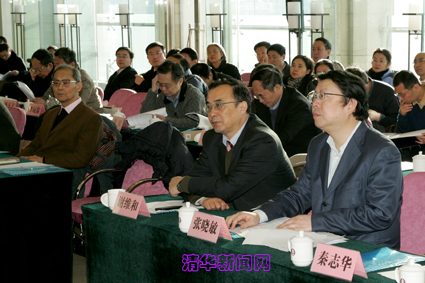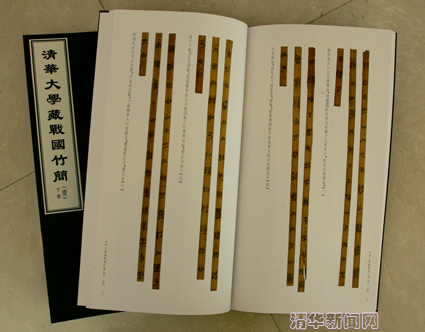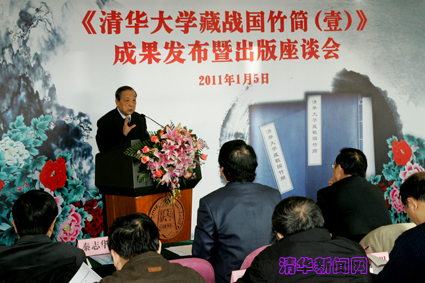
In July 2008, Tsinghua University rescued and received into its collection a massive number of Warring States bamboo strips that had previously been smuggled out of China. These artifacts have been arranged and their quantity calculated. Altogether there are more than 2,500 pieces, some of which are fragments. Most of the inscriptions are texts related to the classics (Jing) and histories (Shi). The Tsinghua bamboo strips are thus concerned with the core of ancient Chinese culture and have already awakened strong interest among researchers both in China and abroad. No doubt this significant discovery will have a broad and deep influence on such disciplines as history, archaeology, ancient character studies and philology.

After two years of intensive effort, the research team, whose first director is Professor Li Xueqin, chief of the Center for Excavated Texts Research and Preservation of Tsinghua University, has completed the compiling work of the Warring States Bamboo Strips Collected by Tsinghua University (Series One). The book was published at the end of 2010 by Zhongxi Shuju of the Shanghai Literature and Art Publishing Group (SLAPG). On January 5th, a news conference and publishing symposium were held at Tsinghua University. Xie Weihe, Tsinghua University Vice President, and Zhang Xiaomin, Board Chairman of SLAPG, both spoken at the ceremony. More than forty scholars and other experts attended, including Professor Qiu Xigui from Fudan University and Professor Huang Dekuan from Anhui University. As the chief editor of the book, Professor Li Xueqin introduced its main content, and academic and cultural value.

The research team of Tsinghua University has discovered more than 60 texts and plans to publish 15 series of arrangement reports. The first series contains nine chapters, including "Yin Zhi", "Yin Gao", "Cheng Wu", "Bao Xun", "Qi Ye", "Jin Teng", "Huang Men", "Zhai Gong" and "Chu Ju". The whole book was edited and published in accordance with standards for arrangement reports. It contains photographs of the front and back of each bamboo strip in their original color and size, as well as photos of characters magnified two-fold. Transcription, annotation and character collection are also attached. Its main content and value to both scholarship and culture can be summarized under the following five points:
1. To represent the Book of Historical Documents (Shang Shu) and similar classical texts.
The first eight of the nine chapters of Warring States Bamboo Strips Collected By Tsinghua University (Series One) are from The Book of Historical Documents and similar classical texts. The Book of Historical Documents, a collection of ancient texts, is the most important source for research in pre-Qin history. Confucius was said to have compiled The Book of Historical Documents, and his version had as many as 100 chapters, most of which, however, were lost because of Qin's "burning of books". At the beginning of the Han Dynasty, Fu Sheng from Jinan transmitted 28 chapters, which were called the "New Text" Shang Shu. At a late stage of the reign of the Han Emperor Jing (or in the opinion of some scholars during the time of Emperor Wu), the "Old Text" Shang Shu, which had 16 additional chapters, was excavated from the wall of Confucius' home in Qufu, but it then disappeared in the mist of history. Another version, called "Qi Shu" (writing in lacquer), which Dulin obtained from Xizhou, was not passed down, either. More than two thousand years then passed before the Tsinghua bamboo strips were discovered.
"Jin Teng" is found in both the "New Text" Shang Shu transmitted from Fusheng and the Tsinghua bamboo strips. The title of the bamboo strip version is "King Wu was sick and the Duke of Zhou wished to suffer the disease for his lord". "Jin Teng" is an important chapter in The Book of Historical Documents. It recounts that shortly after eliminating Shang Zhou's King Wu was sick in bed and the Duke of Zhou, the King's brother, prayed to suffer the disease for him, which showed the Duke of Zhou's loyalty. Compared to the transmitted version, there are many differences in Tsinghua bamboo strips. These are extremely important for research in early Zhou history. Take the following as an example: According to the bamboo strips, King Wu got sick three years after the elimination of Shang, while the transmitted version indicates only two years. Several sentences about augury in the transmitted version are not found in the bamboo strips. In the latter, it is said that "the Duke of Zhou lived in the east for three years", while in the transmitted record we read: "The Duke of Zhou lived in the east for two years."
In the Tsinghua bamboo strips, there are also classical texts similar to The Book of Historical Documents that had not been previously seen, such as "Bao Xun" in the first series, which has never been known from the “burning of books”. The bamboo strips of "Bao Xun" record the last words of Zhou's King Wen to his royal heir (who became King Wu) and mentions two tales about Shun and Shang's distant ancestor Shang Jia-Wei. The idea of "Zhong" (middle, centre) contained in this chapter has many philosophical meanings. Its materials were published and have already stimulated a great discussion in the scholarly world.
2. To clarify some long-standing perplexities long existent in Chinese historical scholarship.
The Book of Historical Documents in current Shisan Jing Zhushu claims to be the "old text" version from the wall of Confucius' home. Many scholars' research after Song has proved it to be a later forgery. However, until now some researchers have sought to reverse that conclusion. The real "old text" Shang Shu in the Tsinghua bamboo strips can be of great significance for ending this controversy.
Regarding the history of Shang's King Tang eliminating Xia, "Yin Zhi" and "Yin Gao" are documents of great importance about Yi Yin and Shang Tang. "Yin Gao", also named "Xian You Yide", is one important chapter of the "old text" of Shang Shu. It was excavated from the wall of Confucius' home but subsequently lost. Comparing "Yin Gao" in the Tsinghua bamboo strips with "Xian You Yide" of the transmitted "old text" Shang Shu, we can be certain that the transmitted version is a later forgery, while the bamboo strip version is genuine. This will deeply influence Chinese historical research.
The Tsinghua bamboo strips can also prove that some chapters of Yi Zhou Shu are no less significant than The Book of Historical Documents, such as the well-preserved strips of "Zhai Gong" and "Huang Men". "Huang Men" recorded that the Duke of Zhou admonished chancellors to assist with his rule by faithfully counseling and recommending the virtuous. "Zhai Gong" includes the last advice of Zhai Gong Moufu, a chancellor of Zhou's King Mu, as he approached the end of his life. These two documents are of great historiographical value. The scripts, which are quite similar to inscriptions on bronze (Jin Wen), are archaic and abstruse. Through comparisons with them, many errors in the transmitted version can be corrected.
"Cheng Wu" is also found in the Tsinghua bamboo strips. This chapter was once included in Yi Zhou Shu during the Han dynasty, but it was lost after the Tang or Song dynasty. Only fragments of it still exist. By contrast, "Cheng Wu" in the Tsinghua bamboo strips is a complete text, recording in detail Zhou's King Wen "being chosen" (Shou Ming, that is, having a claim to the throne of King and thus replace Shang). This sheds further light of this legend and might compensate for the loss during the last thousand years.
3. To discover previously unknown odes and songs from the Zhou Dynasty.
The "Qi Ye" chapter in the Tsinghua bamboo strips indicates that in the eighth year of King Wu's reign, after the Zhou generals had returned from their successful punitive attack on the state of Qi (that is, Li), they held a "Yin Zhi" ceremony in the ancestral temple of King Wen. Among those participating were King Wu, the Duke of Zhou, the Duke of Bi, the Duke of Zhao, Xin Jia, Zuo Ce Yi, and Shi Shang Fu. In their ritual, they drank liquor and composed odes. All those odes are found on the bamboo strips. This relates to the "Chief of the West Conquers Qi"(Xibo Kan Li) chapter of the "Documents of Shang"(Shang Shu) section in The Book of Historical Documents. According to it, we can correct the mistake of the Great Commentary on Shang Shu (Shangshu Dazhuan) that the attack on Li was during King Wen's reign. This bamboo text thus has both historical value and literary significance. Surprisingly, one stanza of the ode composed by the Duke of Zhou is closely related to the "Xi Shuai", an ode in the "Airs of Tang"(Tang Feng) section of Shi Jing. This was really outside anyone's expectations.
4. To recover the history and historical geography of the Chu state.
The "Chu Ju" chapter is included in Warring States Bamboo Strips Collected By Tsinghua University (Series One). Its strips are 50 centimeters long, the longest in the Tsinghua bamboo strips. In a style similar to that of the "Ju Pian" chapter of the transmitted ancient book Shi Ben, it records details of every Chu king's descendants and where they lived or the capital was founded, from Chu's legendary remotest ancestor Ji Lian to King Dao (401 B.C. - 381 B.C.) in the middle age of Warring States period. The capital place of every generation and the reasons for migration are also listed. The place names can be compared with those on previously excavated Chu bamboo strips. This information provides many clues for research into Chu's historical geography and relics, and it will certainly deepen the study on Chu culture.
The places of residence and migrations recorded in this chapter prove that most of the "Chu Shijia" in Shi Ji is correct. Some conflicts between them can be resolved by reference to other texts. The legend of Chu's ancestors at the beginning is also important. Especially it mentions the connection between Chu's ancestors and the offspring of Shang's King Pan Geng, as well as the relationship between the Chu and Nuo state, both of which are worthy of extensive reflection.
5. To provide precious textual materials for ancient character study, specially in Chu characters.
The nine chapters in Warring States Bamboo Strips Collected By Tsinghua University (Series One) were written in Chu characters during the Warring States period. The scripts' structure and form are in a special style. Among them, "Jin Teng", "Huang Men" and "Zhai Gong" can be compared with the transmitted version, which will greatly facilitate research in Chu characters and help scholars interpret many of them.
The task of preserving and doing research on the Tsinghua bamboo strips has received enthusiastic attention from leaders of the Communist Party of China and the government, as well as strong support from the National Development and Reform Committee (NDRC), the Ministry of Education (ME), the Ministry of Science and Technology (MST), the Ministry of Culture (MC) and the State Administration of Cultural Heritage (SACH). The ME, the MST and the National Planning Office of Philosophy and Social Science established special programs and offered financial support. In order to preserve these national treasures permanently, the NDRC has already decided to allocate special funds for a thorough promotion of the Tsinghua bamboo strips' preserving condition. Leaders of Tsinghua University believe that the work of preserving and conducting research on them is an important part of the maintenance of Chinese history and culture, as well as a crucial breakthrough and engine for the building up and development of the social sciences and humanities. With special attention and collaborative efforts, related agencies of the University overcame various difficulties and provided tremendous aids and support for work in connection with the Tsinghua bamboo strips.
The publishing of Warring States Bamboo Strips Collected By Tsinghua University (Series One) is a wonderful gift presenting to our Alma Mater on her 100th anniversary. The Tsinghua bamboo strips represent classics lost for more than 2000 years and will make an irreplaceable contribution to the flourishing of Chinese traditional culture. Tsinghua University desires continuous coordination and research centered around the bamboo strips with scholars both in China and abroad. Regarding the release of the Tsinghua bamboo strips as a great opportunity, we decided to strengthen further our support in such disciplines as literature, history and philosophy. With bigger strides in building up and developing humanities, we hope to contribute to establishing Tsinghua as the world-class university.
(Translated by Chen Pengyu from the Center for Excavated Texts Research and Preservation of Tsinghua University.)

